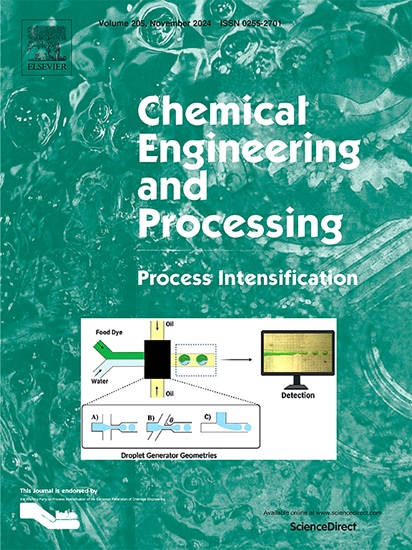不同芯片微反应器连续流合成氯吡格雷及其与间歇法的性能比较:CFD模拟与优化研究
IF 3.9
3区 工程技术
Q3 ENERGY & FUELS
Chemical Engineering and Processing - Process Intensification
Pub Date : 2025-06-07
DOI:10.1016/j.cep.2025.110389
引用次数: 0
摘要
氯吡格雷是一种广泛应用于全球心脏病患者的抗血小板药物。近年来,制药行业越来越多地认识到使用基于流程的方法进行药物生产的优势,而不是传统的批量处理,它提供了改进的性能和安全性,增强的自动化和精确的过程控制。目前的研究调查了在芯片微反应器中使用连续流方法生产氯吡格雷。该研究包括新型微混合器和微反应器的设计和仿真,随后使用激光雕刻技术制造各种几何形状的微流控芯片。氯吡格雷最初采用间歇法合成,随后在微反应器中采用流动法合成,停留时间为25、45和65 min,采用一步合成路线。通过红外光谱(FTIR)、核磁共振光谱(HNMR)、薄层色谱(TLC)和高效液相色谱(HPLC)等分析验证了该药物的产量和产率。结果表明,微反应器C在所有停留时间都优于其他反应器,在停留时间为65分钟的情况下,产品收率为38.9%,而在相当相似的条件下,批次方法的产品收率仅为11.2%。与传统的批处理方法相比,连续流动方法在明显更短的时间内以更安全的方式显示出氯吡格雷的有希望的产量。本文章由计算机程序翻译,如有差异,请以英文原文为准。

Continuous-flow synthesis of Clopidogrel through different chip-microreactors and comparing of performances with that of a batch approach: A CFD simulation and an optimization study
Clopidogrel, is a widely used antiplatelet medication for heart patients globally. In recent years, the pharmaceutical industry has increasingly recognized the advantages of using a flow-based approach to drug production over traditional batch processing, which offers improved performance and safety, enhanced automation, and precise process control. The current research investigated the production of Clopidogrel using a continuous-flow approach in chip-microreactors. The study encompassed the design and simulation of novel micromixers and microreactors, followed by fabricating microfluidic chips with various geometries using laser engraving techniques. Clopidogrel was initially synthesized via the batch method and subsequently using a flow approach in the microreactors, with residence times of 25, 45, and 65 min, via a one-step synthesis route. The production and yield of the drug were validated through FTIR, HNMR, TLC, and HPLC analyses. The results indicated that microreactor C outperformed the others at all residence times, achieving a product yield of 38.9 % with a residence time of 65 min, compared to only 11.2 % from the batch approach under quite similar conditions. The continuous-flow approach demonstrated a promising yield of Clopidogrel in a significantly shorter duration of time and in a safer manner compared to the conventional batch procedure.
求助全文
通过发布文献求助,成功后即可免费获取论文全文。
去求助
来源期刊
CiteScore
7.80
自引率
9.30%
发文量
408
审稿时长
49 days
期刊介绍:
Chemical Engineering and Processing: Process Intensification is intended for practicing researchers in industry and academia, working in the field of Process Engineering and related to the subject of Process Intensification.Articles published in the Journal demonstrate how novel discoveries, developments and theories in the field of Process Engineering and in particular Process Intensification may be used for analysis and design of innovative equipment and processing methods with substantially improved sustainability, efficiency and environmental performance.

 求助内容:
求助内容: 应助结果提醒方式:
应助结果提醒方式:


